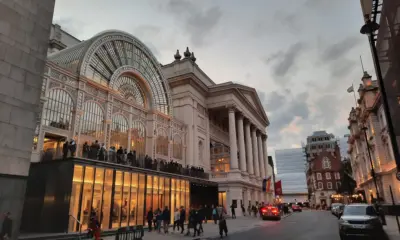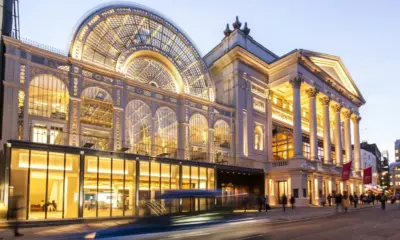Entertainment
West End Revival: How Theatre Adapted to the Streaming Generation

London’s West End is experiencing a renaissance in 2025, blending its storied theatrical tradition with the demands of a streaming-savvy audience. Analysts from the British Theatre Association, BBC Culture, and Reuters note that this revival is driven by a combination of innovative programming, hybrid performance models, and digital engagement. Faced with competition from streaming platforms, West End producers are rethinking how theatre is delivered, marketed, and monetized, ensuring the stage remains relevant in an era dominated by on-demand content.
Hybrid Performances and Digital Access
The pandemic accelerated the adoption of digital theatre, and by 2025, West End productions have fully integrated hybrid models. Many shows offer simultaneous live-streamed performances alongside traditional in-person productions. Analysts highlight that hybrid access expands audience reach, particularly to international viewers unable to travel to London. Platforms such as National Theatre Live and private streaming services provide subscription-based access to performances, combining the immersive nature of theatre with the convenience of streaming.
These hybrid models also allow for interactive experiences, such as live Q&A sessions with actors, backstage tours, and behind-the-scenes content. Analysts suggest that this integration not only broadens the audience base but also enhances engagement, building loyalty and increasing repeat viewership. Revenue from streaming subscriptions and pay-per-view models is reported to contribute between 10-15 percent of total box office revenue for major productions in 2025.
Reimagining Programming for Modern Audiences
West End theatres are curating content that appeals to a digitally native generation. Classic plays and musicals are reimagined with contemporary themes, diverse casting, and multimedia elements. Analysts from the British Theatre Association note that productions integrating augmented reality (AR), live video feeds, and dynamic stage designs attract younger audiences while maintaining traditional theatre enthusiasts.
Experimental and immersive theatre experiences are also gaining traction, with productions designed to incorporate audience participation and interactive storytelling. Analysts suggest that such innovation fosters a more compelling live experience, counterbalancing the convenience of streaming platforms. West End producers are leveraging social media marketing, influencer partnerships, and targeted campaigns to reach digitally native demographics and sustain engagement.
Economic Impact and Investment Trends
The West End’s revival is attracting renewed investment from both domestic and international backers. Analysts from CBRE and Knight Frank report that private equity and venture capital are increasingly involved in financing productions, theatre refurbishments, and digital infrastructure. Upgrades to acoustics, lighting, and streaming technology not only enhance live performances but also enable high-quality digital distribution.
Tourism and local businesses are benefiting from the revival, as theatre-goers spend on dining, transportation, and accommodation. According to the ONS, West End ticket sales and ancillary spending contributed over £1.2 billion to the London economy in the first half of 2025, reflecting both domestic recovery and the return of international audiences. Analysts emphasize that hybrid digital offerings complement traditional box office revenue, creating multiple income streams for producers and investors alike.
Audience Engagement and Demographic Shifts
West End producers are adapting to the preferences of younger audiences accustomed to streaming platforms and on-demand content. Data indicates that viewers aged 18–35 now account for nearly 40 percent of hybrid performance attendance, highlighting the importance of digital marketing, interactive experiences, and social media engagement. Analysts note that integrating technology into theatre production enhances accessibility, enabling audiences with mobility limitations or geographic constraints to participate.
Additionally, inclusive programming that reflects diverse cultural, social, and gender perspectives resonates with modern audiences, broadening appeal and encouraging engagement from underrepresented groups. Collaborative initiatives with schools, universities, and community organizations also foster educational outreach, cultivating the next generation of theatre-goers.
Challenges and Strategic Considerations
Despite the positive trends, West End producers face challenges in balancing live and digital experiences. Analysts highlight the cost of implementing high-quality streaming infrastructure, licensing for digital distribution, and maintaining production value for live audiences. Moreover, pricing strategies must be calibrated to ensure that digital access does not cannibalize ticket sales while maximizing revenue potential.
Competitive pressure from global streaming platforms requires continuous innovation in content, marketing, and audience engagement. Analysts emphasize that West End success will depend on the ability to create unique, high-quality theatrical experiences that complement, rather than compete with, streaming entertainment.
Innovation Driving the Revival
Technological integration is central to the West End revival. Productions increasingly use motion capture, AR overlays, and live multi-camera feeds to enhance both live and streamed experiences. Analytics from streaming platforms provide insights into audience preferences, viewing habits, and engagement levels, allowing producers to refine programming and marketing strategies. Analysts suggest that this data-driven approach ensures content aligns with audience expectations, fostering loyalty and increasing attendance for both digital and in-person performances.
Collaboration with international producers and co-productions also introduces creative cross-pollination, attracting global attention and investment. Analysts report that international co-productions account for 20 percent of new productions in 2025, reflecting the growing interconnection between London’s theatre ecosystem and global markets.
Future Outlook: Sustained Growth and Cultural Impact
Looking ahead, West End theatre is expected to continue its hybrid expansion, blending live performance with streaming access. Analysts predict that this model will become the standard for sustaining audience engagement, particularly among younger and international demographics. Investment in digital infrastructure, audience analytics, and creative experimentation will further enhance the sector’s resilience and global appeal.
By combining traditional stagecraft with innovative delivery, West End theatres can maintain cultural relevance, attract diverse audiences, and generate multiple revenue streams. Analysts suggest that sustained growth depends on balancing operational costs, production quality, and digital accessibility, ensuring the theatre experience remains compelling for both live and virtual audiences.
Conclusion
The West End revival illustrates the theatre’s ability to adapt to a rapidly changing entertainment landscape. Hybrid performances, innovative programming, and strategic use of technology are transforming traditional theatre into a dynamic, accessible, and globally relevant medium. By embracing the streaming generation while preserving the immersive qualities of live performance, London’s theatres are securing both economic growth and cultural impact. Analysts conclude that the West End’s adaptability, combined with investment in technology and audience engagement, ensures its continued prominence as a hub of creativity, innovation, and performance excellence in 2025 and beyond.














